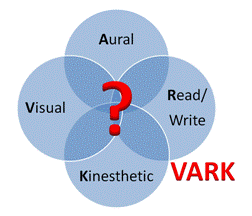One way for figuring out how you learn best – what kind of a learner you are, if you will – is to use the VARK learning styles approach.
VARK stands for...
V isual
A ural (hearing)
R ead/write
K inesthetic
The model categorises people into these four groups, based on how they're likely to learn best.
For example, visual learners will benefit most from using material with a lot visual content like diagrams, pictures or graphs as well as from highlighting or underlining key text, and using lots of different colours. Aural learners, on the other hand, learn best by listening to the material, so it's essential for them to attend their classes!
Those who fall in the read/write group obviously learn most easily by reading, and by writing things down. Kinesthetic learners, on the other hand, need to physically do the thing they're learning. This makes learning in a traditional school or lecture hall environment a challenge, but this can be overcome by using prodigious amounts of real-life examples.
It's also good to keep in mind that around 60% of people are multimodal learners. This means that they often learn best when they combine the techniques of two or more learning styles. For example, I test as a KVR, and I have indeed noticed that I'm unlikely to remember something that I've only heard, if there isn't something concrete or visual I can connect it to.
(Image sources: diagram, vark aardvark)


when i saw vark i thought of aardvark too =D
ReplyDelete